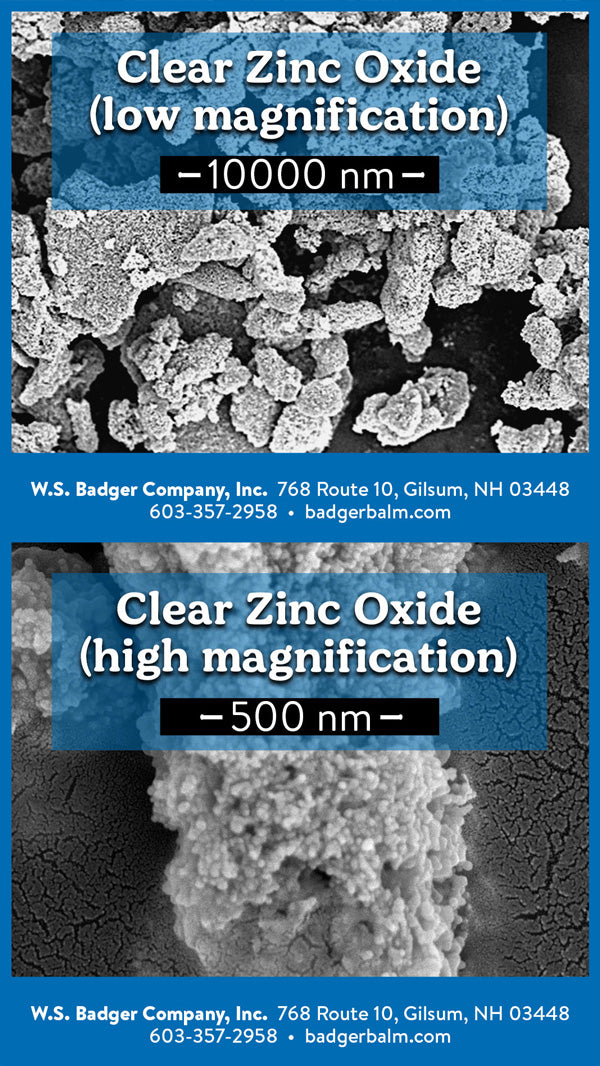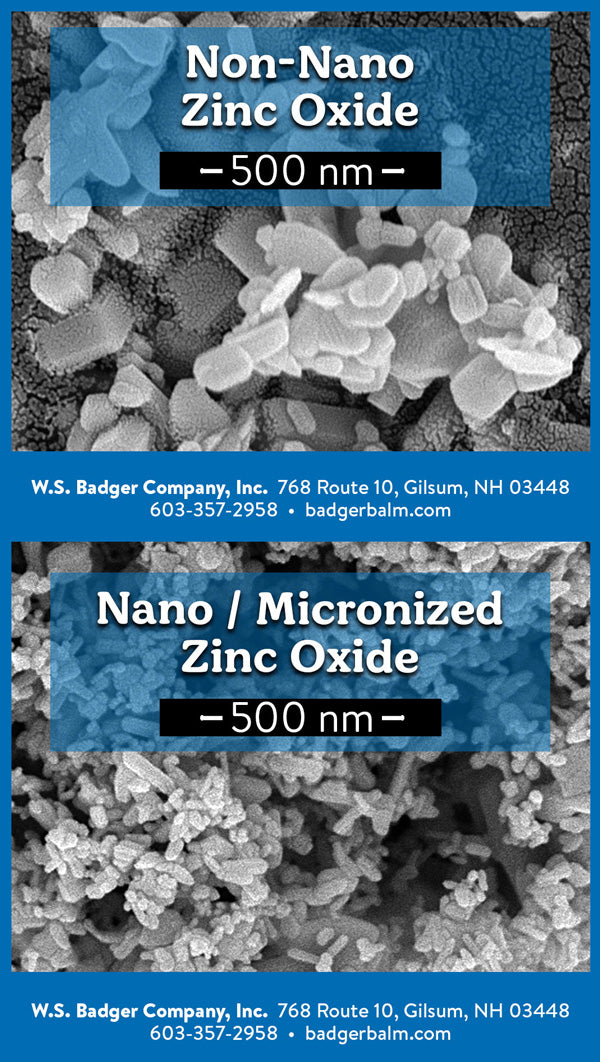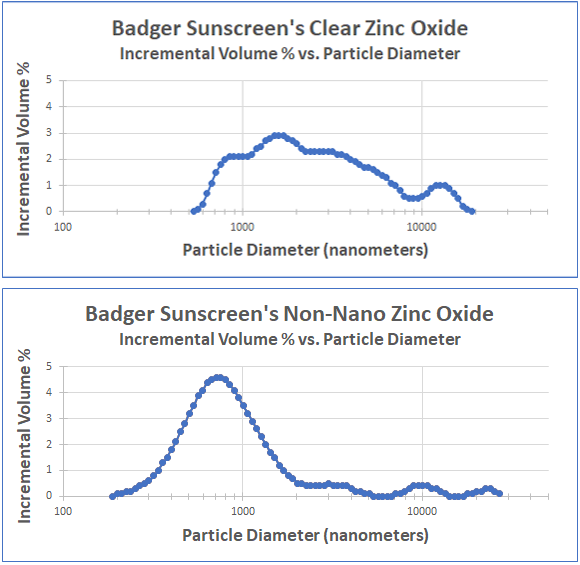Zinc Oxide is a mineral sunscreen that sits on top of your skin
It scatters, reflects, and absorbs harmful UVA and UVB rays.
Zinc oxide is the safest and most effective sunscreen ingredient
The best protection from the sun is to find shade and cover up with clothes and a hat.
Badger Sunscreens use zinc oxide as their only active ingredient
We use the mineral zinc oxide in a base of organic plant oils and beeswax.
What is Zinc Oxide?
Zinc oxide is the metal zinc that has been oxidized. The chemical formula is ZnO, 1 zinc atom and 1 oxygen atom held together by an ionic bond. Zinc oxide does occur in nature as the mineral zincite, but it is rare and commercially unavailable. Badger's zinc oxide is manufactured using mined zinc which is then purified into pharmaceutical grade zinc oxide.

What is clear zinc oxide sunscreen?
Clear zinc oxide is a specialized type of mineral zinc oxide powder whose particles have a porous surface texture (like a sea sponge) that doesn’t reflect as much visible light as standard non-nano zinc oxide and is therefore less whitening on the skin. The large particle size of clear zinc oxide gives it the same outstanding safety and efficacy of standard non-nano zinc oxide. It won't absorb into your body, it won't harm the environment, and it provides excellent UVA and UVB protection.
Is clear zinc oxide safe?
Clear zinc oxide is an approved sunscreen UV filter in the US, the EU, and all major international markets and it meets the natural cosmetic standards of the Natural Products Association (USA) and ECOCERT (EU). After a decade reviewing all the published research and conducting our own independent laboratory analyses on clear zinc oxide we’ve determined that it meets our stringent standards for ingredient safety and efficacy and it is completely safe for us to use in our sunscreens and on our families. As of 2022 we now use clear zinc oxide as the only active ingredient in all our sunscreens.
Is clear zinc oxide nano or non-nano?
Our sunscreens use clear (non-nano) zinc oxide. The top image shows that clear zinc oxide is composed of large particles between about 500 and 9000 nanometers in diameter (5 - 90x larger than nanoparticles). The lower image shows a close up of the zinc oxide crystallites making up the larger particles. You can see that there are no free nanoparticles (which we verified with light scattering analysis).

What is a nanoparticle?
A nanoparticle is a particle smaller than 100 nanometers, or 100 billionths of a meter. These images show that non-nano zinc oxide contains few, if any, particles smaller than 100nm and that most particles appear to be in the 100 to 500nm range. The nano / micronized zinc oxide is made of a variety of smaller particle sizes, most of which have at least one dimension that is smaller than 100nm, classifying it as 'nano'.

In addition anayzing several scanning electron microscope images of zinc oxide (as discussed above) we also hired a third party laboratory to conduct a light scattering analysis of the clear zinc oxide (that we currently use) and non-nano zinc oxide (that we used to use). The results would show us whether or not there are free nanoparticles in the samples, and there are not.
The bumps in the larger (right hand) end of these graphs indicate agglomerates, or the natural sticking together of particles. Because of this we expect that the true particle sizes are somewhat lower than the averages (which include these agglomerates). Note, these samples were taken from our actual sunscreen products, not the raw zinc oxide ingredient.
Clear Zinc Oxide results show a particle size range of 565nm to 19,000nm with an average particle size of 3400nm and no detectable nanoparticles.
Non-Nano Zinc Oxide results show a particle size range of 200nm to 26,000nm with an average of 1500nm and no detectable nanoparticles.

What is clear zinc oxide sunscreen?
Clear zinc oxide is a specialized type of mineral zinc oxide powder whose particles have a porous surface texture (like a sea sponge) that doesn’t reflect as much visible light as standard non-nano zinc oxide and is therefore less whitening on the skin. The large particle size of clear zinc oxide gives it the same outstanding safety and efficacy of standard non-nano zinc oxide. It won't absorb into your body, it won't harm the environment, and it provides excellent UVA and UVB protection.
Is clear zinc oxide safe?
Clear zinc oxide is an approved sunscreen UV filter in the US, the EU, and all major international markets and it meets the natural cosmetic standards of the Natural Products Association (USA) and ECOCERT (EU). After a decade reviewing all the published research and conducting our own independent laboratory analyses on clear zinc oxide we’ve determined that it meets our stringent standards for ingredient safety and efficacy and it is completely safe for us to use in our sunscreens and on our families. As of 2022 we now use clear zinc oxide as the only active ingredient in all our sunscreens.
Is clear zinc oxide nano or non-nano?
Our sunscreens use clear (non-nano) zinc oxide. The top image shows that clear zinc oxide is composed of large particles between about 500 and 9000 nanometers in diameter (5 - 90x larger than nanoparticles). The lower image shows a close up of the zinc oxide crystallites making up the larger particles. You can see that there are no free nanoparticles (which we verified with light scattering analysis).

What is a nanoparticle?
A nanoparticle is a particle smaller than 100 nanometers, or 100 billionths of a meter. These images show that non-nano zinc oxide contains few, if any, particles smaller than 100nm and that most particles appear to be in the 100 to 500nm range. The nano / micronized zinc oxide is made of a variety of smaller particle sizes, most of which have at least one dimension that is smaller than 100nm, classifying it as 'nano'.

In addition anayzing several scanning electron microscope images of zinc oxide (as discussed above) we also hired a third party laboratory to conduct a light scattering analysis of the clear zinc oxide (that we currently use) and non-nano zinc oxide (that we used to use). The results would show us whether or not there are free nanoparticles in the samples, and there are not.
The bumps in the larger (right hand) end of these graphs indicate agglomerates, or the natural sticking together of particles. Because of this we expect that the true particle sizes are somewhat lower than the averages (which include these agglomerates). Note, these samples were taken from our actual sunscreen products, not the raw zinc oxide ingredient.
Clear Zinc Oxide results show a particle size range of 565nm to 19,000nm with an average particle size of 3400nm and no detectable nanoparticles.
Non-Nano Zinc Oxide results show a particle size range of 200nm to 26,000nm with an average of 1500nm and no detectable nanoparticles.
More About Zinc Oxide
The nanoparticle controversy stems from the potential health risks caused by nanoparticles if they were to enter the human body. When a substance is so small that it is measured in nanometers (1 to 100 billionths of a meter), the surface area to volume ratio is so great that the actual properties of the substance may change. One comprehensive review of the scientific literature(1) shows that nano-particles of zinc oxide greater than 30nm do not exhibit properties any different than those of larger non-nano sized particles. Science overwhelmingly shows that particles of zinc oxide greater than 30nm, when applied to the skin in a lotion or cream based product, do not get absorbed into the body, do not enter the bloodstream, and are not a threat to human health.(1)(2)(3)(4)(5) There are no studies showing that nanoparticles of zinc oxide can penetrate healthy human skin, whereas chemical sunscreen ingredients, which are molecular in size and thus significantly smaller than nanoparticles, are designed to be absorbed into the skin, and thereby they can get into the blood. The biggest concern with nanoparticles in cosmetics is the threat of inhalation when they are used in powders and sprays. This is not a concern when the zinc oxide is dispersed in a cream or lotion base. Even the Environmental Working Group recommends the use of nano-sized mineral sunscreens over chemical sunscreens.
Additionally there are studies showing that very small nanoparticles (smaller than 35nm) of uncoated zinc oxide and uncoated titanium dioxide can be harmful to the environment by being toxic to marine life. The extremely small size of these particles generates oxidative stress under UV light potentially causing cellular damage to sensitive organisms such as coral or juvenile fish and invertebrates.
Many mineral sunscreens use nano sized zinc oxide because it is less whitening and therefore more aesthetically appealing than larger particle zinc oxide. Even though we believe that nanoparticle zinc oxide is safe and effective (all research has shown that particles in the size range used in sunscreens (>30nm) do not penetrate the skin and are completely safe to use in sunscreen creams and lotions), we've chosen to not use nano zinc oxide for a few reasons: 1) our customers have insisted that they don't want nanoparticles in our sunscreens; 2) we've figured out a method of working with larger particle zinc oxide that allows us to use a minimal amount of zinc oxide making it less whitening than other mineral sunscreens; and 3) we would rather not use nanoparticles if we don't need to because of their shorter record of safe use and their potential environmental concerns.
Zinc oxide is one of only 17 active ingredients currently approved by the FDA for use in sunscreens. Upon application, zinc oxide particles sit on the outermost layer of your skin, the stratum corneum, where they scatter, absorb, and reflect ultraviolet radiation, protecting your living skin below. Zinc oxide is unique among sunscreen ingredients in that it is truly a broad-spectrum blocker, protecting from UVA, UVB, and even UVC. Titanium dioxide is another mineral active ingredient you may see in other sunscreens. While it protects from UVB rays very well it does not protect from UVA as well as zinc oxide does.
Many sunscreens use zinc oxide particles that have been coated with an inert substance, usually triethoxycaprylylsilane, to make it easier to mix with the other ingredients and less photo-reactive. At Badger we decided to only use uncoated pharmaceutical grade zinc oxide in our products for the following reasons: 1) triethoxycaprylylsilane and the other coatings are not in alignment with our ingredient standards; 2) we don't consider it important to the safety of larger particle non-nano zinc oxide that we use; 3) we've developed an effective way to mix uncoated zinc oxide into our sunscreen base while maintaining a smooth aesthetically appealing product; and 4) uncoated zinc oxide has been safely used in topical skin care products such as calamine lotion and diaper rash cream for centuries.
Zinc oxide, like most powders, can be a health risk if inhaled, but this is not a concern with cream and lotion-based sunscreens. Zinc oxide can also be somewhat photo-reactive, meaning that UV rays can generate reactive oxygen species (free radicals) which again is not a concern with sunscreens because the zinc oxide particles stay on top of the stratum corneum (the outer dead layer of skin) and any free radicals will not affect living cells below.(4) In addition, the rate of reactivity with the zinc oxide Badger uses is still very low compared to that of titanium dioxide, nanoparticle zinc oxide, and many other chemical sunscreen active ingredients.(6)
Furthermore, the inactive ingredients in our sunscreens such as Organic Sunflower Oil and Vitamin E provide powerful antioxidants which help scavenge, or absorb, free radicals.
We've determined that zinc oxide is the safest, most effective active sunscreen ingredient available. It also stands alone in that it is a truly effective, single-ingredient, broad spectrum blocker, meaning that it protects from UVA, UVB, and even UVC rays. Zinc oxide, the main ingredient in calamine lotion and diaper cream, has a time tested safety record having been used in theraputic skin care preparations for centuries.
You generally have to use a lot of zinc oxide and/or titanium dioxide to get an effective SPF value. This makes these mineral sunscreens expensive and whitening, so not everyone likes it. Have you noticed how much less expensive chemical based sunscreens are compared to mineral sunscreens? We feel that peace of mind is worth the additional cost and a little whitening on the skin.
We think that titanium dioxide is safe and effective for protection against UVB (and some UVA) rays, however, titanium dioxide should always be used in combination with zinc oxide to attain true broad spectrum protection. Truthfully, we think titanium dioxide received an unfair reputation when a 2011 Swiss study(7) likened titanium dioxide to asbestos. The study was referring to its toxicity when inhaled, which is not a threat with sunscreen creams. The media did not seem to understand this and wrote alarmist stories about the dangers of sunscreens containing titanium dioxide.
We don't like them. We are concerned about the potential toxic effects of these chemicals when they enter the body and their harmful effect on organisms (such as coral) when they rinse off your skin into the water. Oxybenzone, for example, is in most sunscreens sold in the US. The US Center for Disease Control found that 97% of Americans have oxybenzone in their blood(8). This ingredient has been shown to disrupt normal hormone functions and some health professionals are recommending that products containing this ingredient not be used on babies and kids. We are particularly concerned with the 'continuous spray' chemical sunscreens that are becoming so popular, mainly because of the risk of inhalation.
The term 'chemical-free sunscreens' is commonly used to describe 'physical' or 'mineral' sunscreens, those that use the minerals zinc oxide and/or titanium dioxide as their only active ingredients. Conversely 'chemical sunscreens' use only non-mineral, or chemical, active ingredients such as oxybenzone, oxtinoxate, and octisalate.
Some people argue that every substance under the sun is either a chemical or composed of chemicals, therefore nothing can accurately be called 'chemical-free'. This is technically true, so we've stopped using the term 'chemical free sunscreen' to reduce confusion. Zinc oxide is a mineral that does not dissolve into our sunscreen's inactive ingredients, it does not absorb into your skin nor get into your blood, and we consider it to be significantly different than synthetic sunscreen chemical ingredients that only work by absorbing into your skin. 'Chemical-free sunscreens' is a commonly used term to describe mineral sunscreens and you will probably still see others using this term to describe our sunscreens and others like it.
Shop Zinc Oxide Sunscreens
We here at Badger, and most natural health advocates including Dr. Andrew Weil(9), believe that zinc sunscreens are better for your body than either chemical based sunscreens or exposing your skin to the sun without sunscreen. We closely follow the latest sunscreen research, and we remain convinced that our sunscreens are the most effective and the safest for human health and for the environment (see our page about Sunscreens and Coral Reefs). The best protection from the sun is to stay in the shade or wear protective clothing and a hat. But if you're going to expose your skin to the sun you should protect it, and a zinc sunscreen is the safest and most effective means to that end.

References
(1) Towards a Definition of Inorganic Nanoparticles from an Environmental, Health and Safety Perspective. Auffan et. al. Nature Nanotechnology Sept. 13, 2009.
(2) Environmental Working Group's Sunscreen Guide
(3) Germany's Federal Institute for Risk Assessment (English website)
(4) Australian Government, Review of Scientific Literature
(5) FDAs Nanotechnology Scientific Research Website
(6) Smijs T. & Pavel, S. Titanium Dioxide and Zinc Oxide Nanoparticles in Sunscreens: Focus on Their Safety and Effectiveness; Nanotechnology, Science and Applications 2011:4 95–112.
(7) Amir S., Yazdi, et al. Nanoparticles activate the NLR pyrin domain containing 3 (Nlrp3) inflammasome and cause pulmonary inflammation through release of IL-1 and IL-1β PNAS 2010 107: 19449-19454.
(8) Calafat AM, Wong L-Y, Ye X, Reidy JA, Needham LL 2008. Concentrations of the Sunscreen Agent Benzophenone-3 in Residents of the United States: National Health and Nutrition Examination Survey 2003–2004. Environ Health Perspect 116:893-897
(9) Dr. Andrew Weil M.D.'s Question and Answer Library








